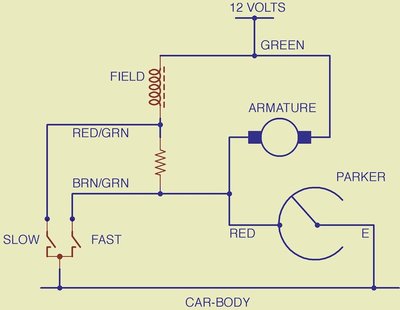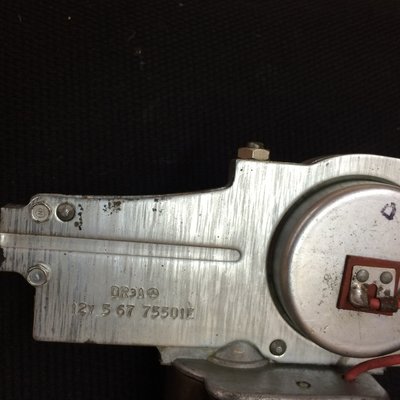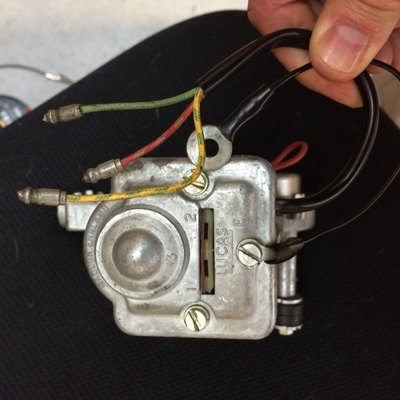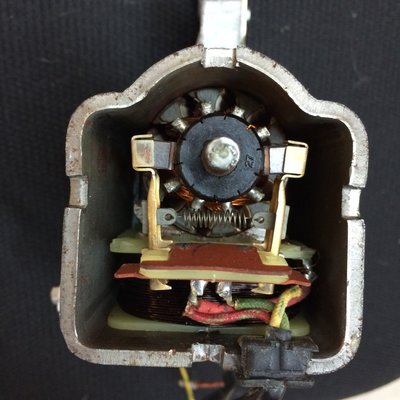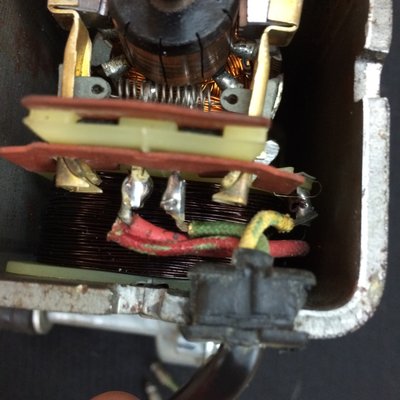Bench testing wiper motor
21 posts
• Page 1 of 2 • 1, 2
I am trying to bench test a NOS Lucas DR3A 2 speed wiper motor for my Elan S2 but not having any luck getting it to run so I have essentially a zero speed motor right now.  This is the early style square housing motor with three wires coming out of the motor plus an earth/ground lead attached to a screw on the motor end cap. As far as I can tell the harness with the three wires contains a green lead for power, a red earth lead for one speed, and a yellow earth lead for the other speed. Attaching the green lead to the + terminal on a spare 12V car battery, the black ground lead to the - terminal and then touching either the red or yellow leads to the - terminal yields some sparks but no motor activity. Touching the red lead to the - battery terminal results in more sparks than the yellow lead so I assume the red lead is for fast speed and the yellow for slow speed. I haven't touched the leads for more than a second at a time to avoid burning up this new motor and when I opened up the motor to make sure I haven't damaged it everything inside still looks brand new. I also cleaned out all of the original grease, re-greased the gearbox, spun the motor armature and found it easy to turn, but it still will not run. The only conclusion I have is that I have the wiring wrong and I don't want to install the motor/wiper assembly only to find out it doesn't operate, so if any of you know the proper way to bench test this motor I am all ears. Thanks in advance for any assistance with this.
This is the early style square housing motor with three wires coming out of the motor plus an earth/ground lead attached to a screw on the motor end cap. As far as I can tell the harness with the three wires contains a green lead for power, a red earth lead for one speed, and a yellow earth lead for the other speed. Attaching the green lead to the + terminal on a spare 12V car battery, the black ground lead to the - terminal and then touching either the red or yellow leads to the - terminal yields some sparks but no motor activity. Touching the red lead to the - battery terminal results in more sparks than the yellow lead so I assume the red lead is for fast speed and the yellow for slow speed. I haven't touched the leads for more than a second at a time to avoid burning up this new motor and when I opened up the motor to make sure I haven't damaged it everything inside still looks brand new. I also cleaned out all of the original grease, re-greased the gearbox, spun the motor armature and found it easy to turn, but it still will not run. The only conclusion I have is that I have the wiring wrong and I don't want to install the motor/wiper assembly only to find out it doesn't operate, so if any of you know the proper way to bench test this motor I am all ears. Thanks in advance for any assistance with this.
'66 Elan S2
'05 Lotus Elise
'96 Ferrari F355 GTS
'05 Lotus Elise
'96 Ferrari F355 GTS
- tesprit
- Second Gear

- Posts: 67
- Joined: 13 Sep 2007
Hello,
I am not a electrical genius and I do not know details, but there are three things I would think of:
first, if the is a "ground screw", use that for ground, and not a cable
second, at least more modern motors have three cable as far as I can remember, one for slow, one for fast and one for power to get into "park position"
third - it could be for negative or positive earth, so "ground screw" could be (+) or (-)
I do not know when cars changed from (+) to (-), your car could be converted, too.
Regards
Guillermo
I am not a electrical genius and I do not know details, but there are three things I would think of:
first, if the is a "ground screw", use that for ground, and not a cable
second, at least more modern motors have three cable as far as I can remember, one for slow, one for fast and one for power to get into "park position"
third - it could be for negative or positive earth, so "ground screw" could be (+) or (-)
I do not know when cars changed from (+) to (-), your car could be converted, too.
Regards
Guillermo
1964 S1 (in boxes)
1967 S3 DHC
1969 S4 FHC
https://theelanman.com for details on Brian Bucklands book.
https://shop.lotus-books.com for more Lotus related books.
We ship worldwide. PM/Email me.
1967 S3 DHC
1969 S4 FHC
https://theelanman.com for details on Brian Bucklands book.
https://shop.lotus-books.com for more Lotus related books.
We ship worldwide. PM/Email me.
- gherlt
- Third Gear

- Posts: 488
- Joined: 20 Jul 2006
updated/edited my posting
this is probably the diagram you are looking for (does not matter if +12V is on car-body, wipers will turn the correct way around because current for field coil AND motor are reversed):
further details from this source:
http://www.britishcarforum.com/bcf/cont ... per-motors
Peter
this is probably the diagram you are looking for (does not matter if +12V is on car-body, wipers will turn the correct way around because current for field coil AND motor are reversed):
further details from this source:
http://www.britishcarforum.com/bcf/cont ... per-motors
Peter
-

crypto - Second Gear

- Posts: 105
- Joined: 20 Apr 2014
Thanks everyone for the replies and thanks Peter for the diagram and link to the DR3A wiper motor information. From the information supplied I know now that I was using the correct connections when testing this motor so something must be wrong with it. I am going to completely tear it down and test the components to see if I can find a fault with the armature, field coil, internal soldered connections, etc. At least these motors are fairly easy to disassemble so hopefully it wont take too long and I will post my findings when I have completed the inspection.
'66 Elan S2
'05 Lotus Elise
'96 Ferrari F355 GTS
'05 Lotus Elise
'96 Ferrari F355 GTS
- tesprit
- Second Gear

- Posts: 67
- Joined: 13 Sep 2007
I finally got a chance to work on the wiper motor this afternoon and found the armature and field winding are both in perfect condition. I reassembled the motor and checked to make sure the armature spun easily and it did so I hooked it up to my 12V battery using green to positive, the black earthing lead to negative, and then touched either the red or yellow wires to negative and again nothing happened except some small sparks at the wire ends when I connected them. I next loosened the auto-parking switch cover and rotated it about 90 degrees, reattached the yellow lead to negative and the motor ran, but only for a couple of seconds before it stopped. I could not get the motor to run at all with the red lead attached to ground no matter where I positioned the auto-parking cover. Rotating the auto-parking cover some more after the motor stopped would get it running again but, only for a couple of seconds at a time. Next, after about 30 seconds of the motor having stopped running and the green and black leads still attached I started to notice the jumper lead to the green wire was getting warm to the touch as well as the motor body so I quickly disconnected the green lead. I removed the end cover from the motor to inspect for any burnt components and found no damage and only hot components. Upon reassembly the motor ran again as before so at least I didn't burn up the motor. What is strange is that the motor appears to be drawing current all the time with only the green and black leads attached to the battery but neither the red or yellow which makes no sense, and I also received some mild electrical shocks to my hands now and again while handling the motor with it powered up.
So now all I can figure is that something is wrong with either the auto-parking part of this wiper motor or it has some sort of an internal short but again, I am no expert. That I received electrical shocks from handling the motor was odd too considering I was only working with a 12V battery. Once again, I have no idea how to proceed from here so I would appreciate any information anyone might have about what is wrong with this motor and how to further diagnose and repair it. Thanks again in advance for any responses.
Dan
So now all I can figure is that something is wrong with either the auto-parking part of this wiper motor or it has some sort of an internal short but again, I am no expert. That I received electrical shocks from handling the motor was odd too considering I was only working with a 12V battery. Once again, I have no idea how to proceed from here so I would appreciate any information anyone might have about what is wrong with this motor and how to further diagnose and repair it. Thanks again in advance for any responses.
Dan
'66 Elan S2
'05 Lotus Elise
'96 Ferrari F355 GTS
'05 Lotus Elise
'96 Ferrari F355 GTS
- tesprit
- Second Gear

- Posts: 67
- Joined: 13 Sep 2007
Congratulations you have discovered the hard way that a collapsing magnetic field in a coil can generate a much higher voltage than the supply voltages.

It's the same principle as the spark coil.

It's the same principle as the spark coil.
Bill Williams
36/6725 S3 Coupe OGU108E Yellow over Black.
36/6725 S3 Coupe OGU108E Yellow over Black.
- billwill
- Coveted Fifth Gear

- Posts: 4405
- Joined: 19 Apr 2008
Bill Williams
36/6725 S3 Coupe OGU108E Yellow over Black.
36/6725 S3 Coupe OGU108E Yellow over Black.
- billwill
- Coveted Fifth Gear

- Posts: 4405
- Joined: 19 Apr 2008
Thanks for the link. I read through it, but unfortunately the motor in that link was the older DR2 single speed which is very easy to understand and repair as well as being easy to find a replacement. It turns out Lotus used a rather obscure version of the 2-speed DR3A that is both rare and expensive to find a replacement these days.
'66 Elan S2
'05 Lotus Elise
'96 Ferrari F355 GTS
'05 Lotus Elise
'96 Ferrari F355 GTS
- tesprit
- Second Gear

- Posts: 67
- Joined: 13 Sep 2007
Peter,
Here are some photos of the motor and the internal/external wiring.
I did some more experimenting with the motor after reading that the red and yellow wires are both attached to ground for the motor to run on slow speed and the yellow wire is disconnected from the red wire leaving the red wire attached to ground for high speed. I set up my jumper wires as before with green to positive and black to negative and then attached the red and yellow wires together and connected them to ground and the motor ran smoothly on slow speed with no issues and self parked when I disconnected the yellow and red wires but kept them attached to each other. If I removed the yellow wire from the red wire and kept the red wire attached to negative the motor would briefly speed up and then immediately stop as if the motor had a brake in it. With only the red wire attached to negative the motor should have continued to run on high speed. If I kept the red and yellow wires connected together after removing them from negative and allowed the motor to auto park itself, there also was no continued current flow through the green wire and the motor would be completely shut off. This leads me to believe there is something wrong with the high speed resistance winding in the field coil or possibly that it is shorted out. Do any of you have an idea of what is happening to cause the motor to not run on the red wire? If no one has an idea my next step will be to contact Alan Turner per the recommendation from Graeme.
Dan
Here are some photos of the motor and the internal/external wiring.
I did some more experimenting with the motor after reading that the red and yellow wires are both attached to ground for the motor to run on slow speed and the yellow wire is disconnected from the red wire leaving the red wire attached to ground for high speed. I set up my jumper wires as before with green to positive and black to negative and then attached the red and yellow wires together and connected them to ground and the motor ran smoothly on slow speed with no issues and self parked when I disconnected the yellow and red wires but kept them attached to each other. If I removed the yellow wire from the red wire and kept the red wire attached to negative the motor would briefly speed up and then immediately stop as if the motor had a brake in it. With only the red wire attached to negative the motor should have continued to run on high speed. If I kept the red and yellow wires connected together after removing them from negative and allowed the motor to auto park itself, there also was no continued current flow through the green wire and the motor would be completely shut off. This leads me to believe there is something wrong with the high speed resistance winding in the field coil or possibly that it is shorted out. Do any of you have an idea of what is happening to cause the motor to not run on the red wire? If no one has an idea my next step will be to contact Alan Turner per the recommendation from Graeme.
Dan
'66 Elan S2
'05 Lotus Elise
'96 Ferrari F355 GTS
'05 Lotus Elise
'96 Ferrari F355 GTS
- tesprit
- Second Gear

- Posts: 67
- Joined: 13 Sep 2007
Dan
It seems the resistor (between red and yellow) is gone or has bad/no connection.
Comparing the drawing and your photos, there are some differences. In your pic, the red/green is connected to the red inside going to the ring contact. In the drawing it is brown/green going to the red ring contact. In other words, the wire labeling in the diagram (for fast/slow) needs to be swapped to match your picture.
Can you measure the resistance between your connectors ? The resistor should have about 10 Ohm, the field winding about 9 Ohm and the armature about 1 Ohm. If you measure between red and yellow you should have about 5 Ohm, if it shows about 10 Ohm, your resistor is gone (or has bad connection).
Try doing the same test again, but this time have an external 10 Ohm resistor between red and yellow. Let the motor run with red & yellow shorted and connected to ground. Now disconnect yellow from your red, current will now flow via the external resistor to red (and to ground). Disconnect red from ground, and the motor should park.
I forgot to mention, the external resistor should have suitable power rating (e.g. 10W)
Peter
It seems the resistor (between red and yellow) is gone or has bad/no connection.
Comparing the drawing and your photos, there are some differences. In your pic, the red/green is connected to the red inside going to the ring contact. In the drawing it is brown/green going to the red ring contact. In other words, the wire labeling in the diagram (for fast/slow) needs to be swapped to match your picture.
Can you measure the resistance between your connectors ? The resistor should have about 10 Ohm, the field winding about 9 Ohm and the armature about 1 Ohm. If you measure between red and yellow you should have about 5 Ohm, if it shows about 10 Ohm, your resistor is gone (or has bad connection).
Try doing the same test again, but this time have an external 10 Ohm resistor between red and yellow. Let the motor run with red & yellow shorted and connected to ground. Now disconnect yellow from your red, current will now flow via the external resistor to red (and to ground). Disconnect red from ground, and the motor should park.
I forgot to mention, the external resistor should have suitable power rating (e.g. 10W)
Peter
-

crypto - Second Gear

- Posts: 105
- Joined: 20 Apr 2014
Peter,
Thanks for the insight and testing recommendations. I just measured the resistance between the yellow and red wires and it was 10.5 Ohm so it looks like the resistor is no good. I did some more research and found that Lucas did not use a regular resistor on these motors, but rather to save cost they added a resistance wire wound around the field coil along with the regular winding so the only way to repair this would be to add an external resistor as you described or replace the entire field coil. I should probably completely remove the field coil from the outer housing and give it another close inspection to see if there is a bad connection or damage, but it looks like an added resistor will be the easiest and least expensive way to repair this. Would you have a recommendation for a suitable 10 Ohm, 10W resistor to add that will withstand the current of the motor under load without overheating and also could be installed within the motor housing?
Dan
(I forgot to mention that I had already measured the resistance of the armature winding and it was 1.2 Ohm with no shorts or dead spots on the commutator ring when I took apart the motor for the first time.)
Thanks for the insight and testing recommendations. I just measured the resistance between the yellow and red wires and it was 10.5 Ohm so it looks like the resistor is no good. I did some more research and found that Lucas did not use a regular resistor on these motors, but rather to save cost they added a resistance wire wound around the field coil along with the regular winding so the only way to repair this would be to add an external resistor as you described or replace the entire field coil. I should probably completely remove the field coil from the outer housing and give it another close inspection to see if there is a bad connection or damage, but it looks like an added resistor will be the easiest and least expensive way to repair this. Would you have a recommendation for a suitable 10 Ohm, 10W resistor to add that will withstand the current of the motor under load without overheating and also could be installed within the motor housing?
Dan
(I forgot to mention that I had already measured the resistance of the armature winding and it was 1.2 Ohm with no shorts or dead spots on the commutator ring when I took apart the motor for the first time.)
'66 Elan S2
'05 Lotus Elise
'96 Ferrari F355 GTS
'05 Lotus Elise
'96 Ferrari F355 GTS
- tesprit
- Second Gear

- Posts: 67
- Joined: 13 Sep 2007
just a guess, but would the reason for the extra turns in the field coil be to boost the magnetic field to give more torque?
I seem to recall back EMF and tapped field windings are critical in DC motor control.
But also armature current control can be used in speed control.
I suspect the drawing is over simplified and missing in detail.
Also I have not sailed on DC powered ships for more then 30 years, so my knowledge may be rusty, (a bit like the ships back then)
Jon the Chief
I seem to recall back EMF and tapped field windings are critical in DC motor control.
But also armature current control can be used in speed control.
I suspect the drawing is over simplified and missing in detail.
Also I have not sailed on DC powered ships for more then 30 years, so my knowledge may be rusty, (a bit like the ships back then)
Jon the Chief
- oldchieft
- Third Gear

- Posts: 374
- Joined: 17 Sep 2013
21 posts
• Page 1 of 2 • 1, 2
Total Online:
Users browsing this forum: No registered users and 7 guests

